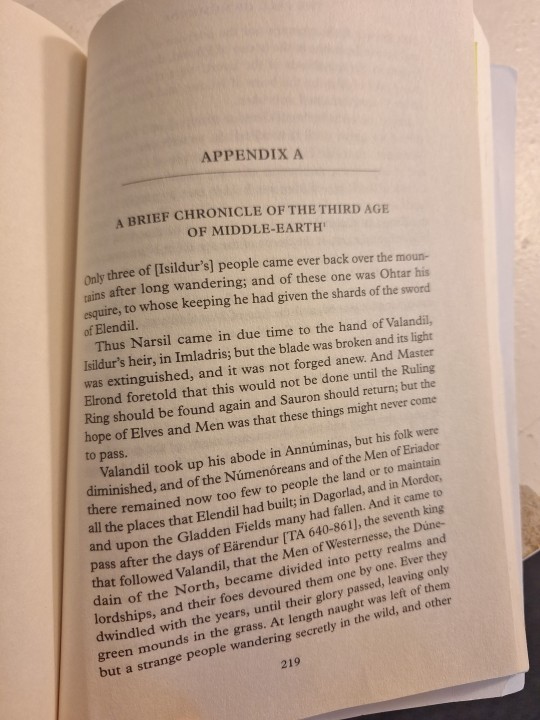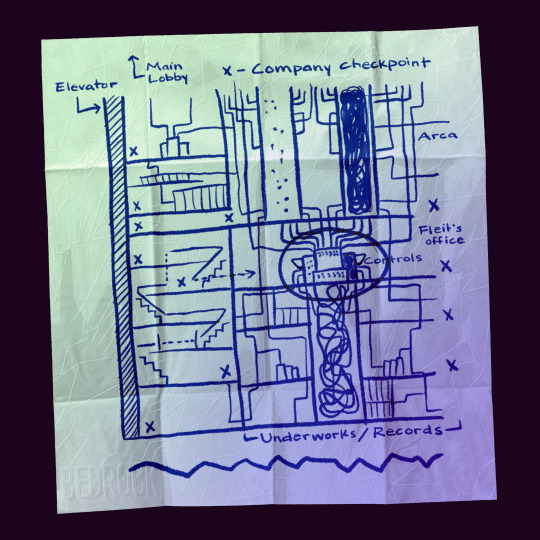#appendices
Explore tagged Tumblr posts
Text
"But Arwen went forth from the House, and the light of her eyes was quenched, and it seemed to her people that she had become cold and grey as nightfall in winter that comes without a star. Then she said farewell to Eldarion, and to her daughters, and to all whom she had loved; and she went out from the city of Minas Tirith and passed away to the land of Lórien, and dwelt there alone under the fading trees until winter came. Galadriel had passed away and Celeborn also was gone, and the land was silent.
'There at last when the mallorn-leaves were falling, but spring had not yet come, she laid herself to rest upon Cerin Amroth; and there is her green grave, until the world is changed, and all the days of her life are utterly forgotten by men that come after, and elanor and niphredil no more east of the sea.'
Here ends this tale, as it has come to us from the South; and with the passing of Evenstar no more is said in this book of the days of old."
The fate of Arwen upon Aragorn's death. Lord of the Rings Appendix A, V. Here Follows a Part of the Tale of Aragorn and Arwen.
125 notes
·
View notes
Text
Someday I WILL write a fic that builds on the incredibly queer dwarf culture that Tolkien hints at in the Appendices
#women with beards#canon ace dwarfs#plus I headcanon high numbers of bi and gay dwarfs too#bc there’s not a lot of women#jrr tolkien#Tolkien#lord of the rings#the lord of the rings#lotr#appendices#tolkien dwarves#gimli son of gloin#the hobbit#my stuff
106 notes
·
View notes
Text

>:)
#Sauron#Annatar#Mairon#all the things#Been listening to epic a bit too much recently#specifically ruthlessness~#Which I could imagine Sauron singing if you take out the son part#just felt like he fit the vibes#yknow?#this'd be first age sauron btw#the lord of the rings#lotr fanart#sauron fanart#the silmarilion#tolkien#middle earth#appendices#sauron the deceiver#hehehe#weekends are great#:D#gives me time to make stuff like this >:D#genuinely quite proud of this#I really like how the shading turned out#:D:D:D
106 notes
·
View notes
Text
#lotr#tolkien#lord of the rings#silmarillion#appendices#I definetly do#my favourites are#appendix a and b#especially the tale of years#and the maps!#if they count
22 notes
·
View notes
Text
For those who don't know, "My One and True Enemy" was my first Haladriel fic, published right after S2 ended. I've evolved a lot in my writing since then, so I sometimes go back to this and improve it. I just finished a thorough revision, adjusting dialogue and descriptions in all chapters. It's essentially the same fic I published between October and November, but improved and much longer! We went from initial 15K words to 18K words. There are 3,000 new words!
I encourage you to read it a try (or reread it). You'll like it 😍
https://archiveofourown.org/works/60067612/chapters/153265270

#halbrand#sauron#annatar#galadriel#haladriel#saurondriel#annatariel#galadriel x halbrand#halbrand x galadriel#sauron x galadriel#galadriel x sauron#annatar x galadriel#galadriel x annatar#elrond#elrond peredhel#celebrian#half maia celebrian#elrond x celebrian#celebrian x elrond#gil galad#arondir#the rings of power#the lord of the rings#appendices#lotr#second age#enemiestolovers#darkromance#charlie vickers#morfydd clark
19 notes
·
View notes
Text
Yeah I had a feeling that I would end up wanting to share thoughts on "Fall of Númenor" Appendices 😅

Appendix A, "A Brief Chronicle of the 3rd Age of Middle Earth": a lot that's in "The Rings of Power & the 3rd Age" (The Silm) but some new to me! Here we go, ty ty!!
1. Ohtar, Isildur's squire, responsible for getting the shards of Narsil back to Valandil. It really can be those acts not from rulers, but from ordinary ppl, that come to matter! V JRRT. BUT Elrond said it wouldn't be reforged "until the Ruling Ring should be found again and Sauron should return."
2. Here's that fading, Arnor diminishing just because there aren't enough of them. They "became divided into petty realms and lordships, and their foes devoured them one by one. Ever they dwindled with the years, until their glory passed....but a strange people wandering secretly in the wild." 🥺🥺🥺
3. Yet, for a time, Gondor thrived! To the point that "it recalled the wealth and majesty of Númenor ere it fell." The White Tree (planted by Isildur in memory of Anárion 😭) "grew before the King's house in Minas Anor." That was until plague hit and wiped out many of the people, including the King & his family (you're up Stewards, the house of Mardil the Faithful). In that vacuum "evil centered again into the Black Land secretly", & the Nazgûl captured Minas Ithil -> Minas Morgul (how dare they defile Isildur's city 😭😭😭). One good thing from this time tho: 👋🏻 Rohan!! 🐴
4. Backing up a bit, meant to add, lol...the ancestry of the Dunedain, being of Isildur's house, "save in Imladris, was forgotten. Yet the shards of the sword were cherished during many lives of Men by the heirs of Isildur, and their line, from father to son, remained unbroken." 😮👀
⚔️💙💍🐴✨️🤓📖📚
#The Fall of Numenor#Appendices#tolkien#tolkien tag#middle earth#jrr tolkien#tolkien legendarium#lord of the rings#isildur#anarion#The Stewards#Cue Aragorn carrying the Shards with him once given by papa Elrond#Dayum he was proud to be Isildur's heir#The Nazgul are the worst#Anywho#Literary analysis#Numenor#Gondor#The fading is sad but arguably just life?
16 notes
·
View notes
Text

Season 3, Episode XV Appendices 🔎 | A Central Vault Schematic
#midst podcast#midst#third person#critical role#midst appendices#appendices#podcast#audio drama#fiction podcast#podcasting#scifi#fantasy#western#surreal#moc weepe#lark#phineas thatch#the trust#blueprint
93 notes
·
View notes
Text
Halo novels need more supplementary material.
Like little afterwords and appendices.
#dougie rambles#personal stuff#halo#gaming#microsoft#bungie#343 industries#halo studios#literature#appendices
4 notes
·
View notes
Text
Favourite Chapter of The Lord of the Rings - Poll 7 of 8
The winners of previous rounds are:
The Fellowship of the Ring: “Strider” and “The Council of Elrond”
The Two Towers: “Treebeard” and “The Window on the West”
The Return of the King: “The Battle of the Pelennor Fields” and “The Steward and the King”
Now, a round for the appendices and other supplementary material!
31 notes
·
View notes
Text
Appendix B: the Tollesian Pantheon
As an additional aid for readers of The First Empress, I typed up a short who's who of the deities mentioned in the story. None of the gods actually show up in the story, and I basically leave it up to readers whether or not said gods actually even exist. Thematically, I want the Tollesian gods to have a similar feel to the Greek Pantheon, without directly copying them straight across.
The Tollesian Pantheon: A Brief Who’s Who Among the First-Generation Tollesian Gods —By Zahnia, the Chronicler
The Tollesian Pantheon (known as the Vestic gods among many non-Tollesian theologians) refers to all of the gods worshiped by the Tollesian-speaking peoples. Like many pantheons, the hierarchy of the Tollesian gods consists of one or more Elder Gods or Titans who created the first generation of offspring gods, who in turn reproduced to create minor gods, demigods, and mortal heroes of divine parentage.
Like many creation stories, Tollesian folklore personifies the Sun as the ever-watchful father of his children here on Mother Earth. The first generation gods, or Titans, are children of the Sun and Earth, who are responsible for the caretaking of the planet and the wellbeing of her inhabitants. And though this volume focuses primarily on Arr and his better-known descendants, modern theologians and classicists estimate as many as five-hundred and seventy deities were worshiped over the course of the Classical-era, with dozens of gods and goddesses falling into and out of obscurity during that seven-hundred-year period. Tollesian legends also mention at least thirty Titans aside from Arr, as well as countless demigods and goddesses. Not to mention giants, monsters, muses, nymphs, wraiths, angels, demons, and even spirits of personified concepts, any of which may or may not also be demi-deities.
Arr God of fate, time, destiny, Tollesianism, judgment, heaven, loyalty, fidelity Patron cities: Aneth, Arr Patuna Symbols: clouds, sundials, scales, dogs, full circles
Arr is the father of the first generation of Tollesian gods and one of few remaining Titans not imprisoned in the Underworld. Having been betrayed by his fellow Titans and forced to imprison many of them during what Tollesian theologians call the Great Division, Arr is inherently mistrustful of deities outside his family and is even more mistrustful of foreigners who follow non-Tollesian gods. Arr is most popular among the more isolationist city-states upon the Vestic Sea. Non-Tollesian theologians often suggest that Arr’s judgmental attitude toward xenoi was the religious and thereby cultural cause of many Classical-Era Tollesians’ mistrust of foreigners and foreign gods.
Thanusa Goddess of death, rebirth, fertility, mortality, the cycle of life and death Patron Cities: Pultus, Tiphilia Symbols: rabbits, flowers, beehives, eggs, vulvas, skulls, the Phoenix
Thanusa is Arr’s wife, fellow Titan and mother of the first generation of Tollesian gods. It’s not ucommon for modern historians and worshippers to misunderstand Thanusa’s role as goddess of death in Classical Tollesian theology. Earlier portrayals depicted her as a guide or guardian ensuring that souls of those who’ve died find their way to the afterlife. Around the 320s AE the first tragedies and satires came out featuring Thanusa as a callow, unfeeling villainess who cut off lifelines of those whose time had come[1]. The worst offender was whichever playwright invented that trope where the hero or heroine saves their dying loved one by interrupting Thanusa before she can cut their lifeline. Discerning whether someone knows this is a popular method among modern classicists of sorting out the semi-educated.
AndivaGoddess of justice, order, law, civilization, expansion, spread of Tollesian culture Patron cities: Andivel, Vislow, Chyllar Symbols: scales, columns, owls
Andiva is the first-born of Arr and champion of the expansion of Tollesian culture into other lands. As such, she is most popular among major cities which border on barbaroi lands. Like her father, Arr, Andiva is mistrusting of foreign gods, but unlike him encourages nonbelievers to convert to Tollesian religion, thought, and culture.
Zupor God of strife, war, destruction, warriors, physical strength, martial prowess Patron cities: Pellastor, Ryllar, Partha Symbols: spear and shield, hoplite helm, fire
Zupor is known across the Vestic Sea as the god of war and strife, and is the second of Arr’s children. Poleis which follow Zupor most closely tend to have a strong warrior caste—or at least place a special emphasis on having a well-trained force of hoplite elite.
Nyrus God of the sea, sailors, overseas trade, storms, tides, male bisexuality Patron cities: Illarra, Fildor, Tutna Symbols: orcas, waves, tempest, sailing ships
As god of the sea, Nyrus is among the more popular patron gods among costal and island poleis. Third of Arr’s children, Nyrus is also father or grandfather of the Nereids, sea nymphs equally famous for saving or drowning Tollesian sailors.
Cibades God of agriculture, farmers, planting, harvest, wine, brewing, vineyards, fertility Patron cities: Clenia, Mertal, Vindel Symbols: plow, wheat, goblet, grapes, scythe, sickle
God of wine and wheat, Cibades is fourth of Arr’s children, and patron god of polies famous for their wine or beer production and to a lesser degree of breadbasket poleis.
Kralor God of knowledge, learning, wisdom, teachers, students, critical thinking, literacy, writing, science, art, philosophy, music Patron cities: Ovec, Thornic Symbols: scroll, book, abacus, lyre, drum, quill
Though not always most cunning of the gods, Kralor is by far the most learned. Father of the Muses. In the Tollesian tradition of wholeness of body and mind, Kralor is frequently depicted as a warrior-philosopher or scholarly wrestler.
Ido and Iva God and goddess of love, romance, sexuality, fertility, marriage Patron cities: none Symbols: the heart, the lovers, roses, rabbits
Ido and Iva are twin god and goddess of love and romance. While Ido and Iva have no patron cities as such, their clerics and priests are frequently called upon during marriages and rites of fertility in towns and cities across the Vestic Sea.
Ferra Goddess of medicine, healing, physicians, health, sanitation, fertility, wholeness of body and mind, female bisexuality, same-sex marriage Patron cities: Kel Fimmaril, Noro, Ferra Arte Symbols: the serpent, burning incense, mortar and pestle, leaves and herbs, midwives
Ferra is the goddess of health and medicine and was particularly popular among smaller city-states such as Noro and Kel Fimmaril. As a goddess of fertility, theatre frequently portrays Ferra as somewhat overly prolific—sluttish, really—giving birth to nearly half of the second generation of gods, goddesses, and demigods. According to legend, however, Ferra would later marry and forsake all other lovers for her younger sister Avilee.
Suvie Deity of the wilderness, mountains, forests, jungle, hunting and trapping, natural selection, gender queerness, gender nonconformity Patron cities: Gillespar, Hastia Symbols: mountains, trees, bows and arrows
Hermaphrodite deity of the forests, variously portrayed as either a beautiful, bow-toting goddess of the hunt or as a virile, spear-wielding warden of the forests. Additionally, Suvie is the parent and guardian of such forest spirits as wisps, fey, Dryads, Naiads, and fauns.
Avilee Winged goddess of protection, defense, common soldiers, fallen soldiers, bereft mothers and widows, war orphans, battlefield medicine Patron cites: Voris, Ortenia, Aula Symbols: spear, javelin, guard dogs, shepherd’s crook, hoplite armor
Wife of Ferra and youngest of Arr’s children, Avilee is also humblest, most caring, and most protective among the Tollesian pantheon. As such, she is also most beloved among her siblings, often acting as a mediator between her more quarrelsome kindred. Early in life, upon seeing the grief and destruction caused by her brother Zupor’s war and strife, Avilee took it upon herself to protect the common soldiers and care for the victims of war, be they fallen soldiers or bereft families. She is generally depicted with great, hawk-like wings and full hoplite panoply, wielding a spear and shield or bow and arrows.
Second-Generation Tollesian Gods
Vepu God of the afterlife and the Underworld Patron Cities: Tanythe, Zunia Symbols: skulls, bones, ashes, urns
Vepu was a mortal king who so impressed Thanusa with his management skills that she elevated him to godhood to rule and organize the Underworld and its afterlife.
Arrolus God of naval warfare, warships, marines Patron Cities: Descal, Tarsa Symbols: war galley
Arrolus is the son of the war-god Zupor and a Nereid huntress named Gale.
Orova Goddess of night, shadows, trickery Patron Cites: None Symbols: bats, wraiths, shadows, blackness, the moons
Orova is the best-known Tollesian trickster goddess, a daughter of Ferra and an unknown Titan. Her favored ally is a wraith named Anache. Not necessarily evil, Orova is the most chaotic and capricious of the Tollesian gods.
Pharesthus God of smithing, mining, iron and bronze Patron Cites: Velia Cestini Symbols: hammers, ingots, anvils, forges
Pharesthus is the son of Ferra and an ancient giant named Sherto.
Clanti Goddess of merchants and trade Patron Cities: Vislow, Ortenia, Lecne Symbols: coins, purses, scales, trading galleys
Clanti is the oldest daughter of Ferra and Nyrus as well as twin sister of the god Curé. Satirically speaking, she was considered the second-most-important god of the Illaran Confederation.
Curé God of bandits, pirates, burglars, and thieves Patron Cities: Illarra, Adis Symbols: daggers, slings, raiding galleys, purse-cutters
Curé is the son of Ferra and Nyrus and twin brother to Clanti. Both satirically and literally, he was regarded as the most important god of the Illaran Confederation.
Axu God of gender assignment and gender presentation Patron Cities: none Symbols: none
Daughter of Suvie and Ferra, Axu’s primary duty is assigning humans their gender at either at birth or conception, depending on the particular theologian.
[1] Truly, the quickest way for an author or playwright to kill my interest in their work is to portray Thanusa as a villainess. This was a character who felt deeply for those who’d died—especially those who died unjustly—and whose ancient stage-masks nearly always portrayed her weeping. Portraying her as a murderess remains one of the worst character-assassinations in the history of Tollesian literature and theatre.
6 notes
·
View notes
Note
Just wanted to let you know…YOUR FANFICS ARE AMAZING!!! And is lowkey a comedy? Of course not the abuse and the serious issues that happen in the story but like random things 😭 like the part where Deidara and Obito are in love and then Obito finds out that Deidara is in the hospital and jail and is just like…welp….
OBITO AINT SHIT 😭💀💀💀 his ass belongs to the streets
LMAO omg i've never written DeiObi/ObiDei before and it was honestly a lot of fun. That part of the appendices was honestly one of my faves so I'm glad you liked it too hahahah
#i have no idea how old this asks is but i must not have been getting tumblr notifs because there are a bunch i didn't see#so if i missed yours im so sorry i wasn't trying to ignore you#asks#the moss project#appendices
8 notes
·
View notes
Text
0 notes
Text
Stupid, not dumb. Appendices count.
A recurring theme with this people is people making enemies with everyone.
17 notes
·
View notes
Text
I have a stomach bug right now, but I have a sneaking suspicion that it’s appendicitis based on only three things: my paranoia, my bad luck, and the fact that I have 2/5 symptoms
I will update this post tomorrow with a confirmation whether or not it is if anyone’s curious
#appendicitis#appendix#appendectomy#appendices#paranoia#I am deffo a hypochodriac but like for good reasons#like I don’t fake cancer. but like if I’m in pain I look up symptoms and choose the worst disease cause I have really bad luck
1 note
·
View note
Text


Season 3, Episode XVIII Appendices 🔎 | The Journal Of Phineas Thatch #MidstSpoilers
#midst#midst podcast#third person#critical role#midst spoilers#spoilers#podcast#podcasting#fiction podcast#audio drama#midst appendices#appendices#scifi#fantasy#western#surreal#phineas thatch#moc weepe#lark
128 notes
·
View notes
Text
Halo novels need more adjuncts and appendices.
Key word, and.
That means both.
I’ll say that the 2010 rerelease of The Flood did this perfectly.
More or less.
#dougie rambles#personal stuff#halo books#literature#halo#gaming#microsoft#343 industries#halo studios#appendices#adjunct#make it happen#the flood
0 notes